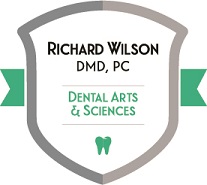Scaling and Root Planing: Please Re-name It!
Scaling and Root Planing is the process of removing dental plaque, tartar (calculus) and toxins from the teeth and thus re-establishing health in gums which were diseased by these noxious agents.
And it really needs a better name.
I have a relative from a faraway city who was once faced with the need for this procedure. She could afford it. She wasn’t afraid of it. She could set aside the time for the two visits required. All the usual objections to treatment did not apply for her. And yet she simply couldn’t bring herself to make the appointments. Why?
Because “I refuse to do something called ‘scaling and root planing.’ Call it something else, and I’ll do it.”
And so her good-listener dentist re-named the procedure “Root Enhancements” and, happy in her self-aware self-deception, she set her jib and sailed through the beneficial procedure without ever looking back.
What is this procedure, and why would someone need it?
As we reviewed on our first page, periodontitis, gum disease, is caused by bacteria under our gumline. These bacteria form plaque, a complex and self-defending stucture that sticks tenaciously to our teeth. They also can form calculus–not the math (which is even worse, in my view) but the hard, chalky tartar that builds up on our teeth over time. Plaque and calculus, as we now understand, cause terrible inflammation under the gums. This leads to bone melting away and eventually, loose teeth and the outright loss of teeth.
What does this all mean for our oral health? I’ll use some of the superb and clear images from the DDS GP app https://www.ddsgp.com/ to illustrate.
Here’s a healthy tooth, with no plaque or calculus at all. An idealized situation that lasts for a brief time after your hygienist or dentist has just finished your professional cleaning:
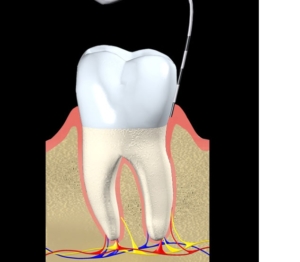
The tan is bone, and the pink is of course gums. There’s always a little separation between gums and tooth, as evidenced by the periodontal probe (something else that desperately needs a rebooted name) angling in to measure this separation. We consider 1 to 3 millimeters to be in the healthy range of these gum measurements.
Now watch as a hypothetical patient doesn’t visit a real, or hypothetical, dentist for some years. We’ll see the biofilm, consisting of soft plaque and hard calculus, build and build and build, damaging the gums and bone along the way:
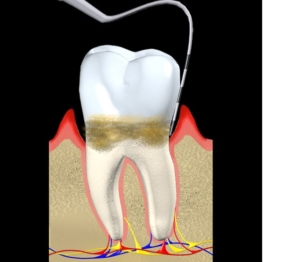
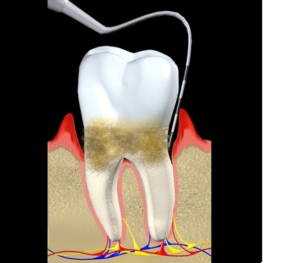
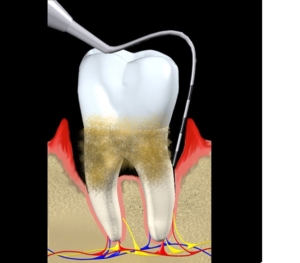
The dental plaque, calculus and toxins are highly irritating to the band of gums around our teeth. The longer they sit there, the deeper the pockets under the gums, the more dangerous the types of germs that move in, and the more inflammation results. It’s a vicious cycle that leads to the jawbone melting away and, eventually, loss of teeth. This is full-fledged gum disease.
Recall, periodontal disease is also relatively painless until near the end.
If we diagnose periodontal disease early enough, while the jawbone is still mostly where it needs to be, we can meticulously clean away the dental plaque and calculus for you, and your body will heal. You may have lost a little supporting bone, but if health is regained (and maintained going forward!) you will still have full chewing function and a beautiful smile.
And we do this by Root Enhancements, which in a bygone, more barbaric age used to be called Scaling and Root Planing. We anesthetize for patient comfort and we use hand instruments and ultrasonic scalers–ah, “enhancers”–which kill the germs and stream them away. Note that we do not remove tooth structure, and we do not cut the gums in these procedures.
It all goes like this:
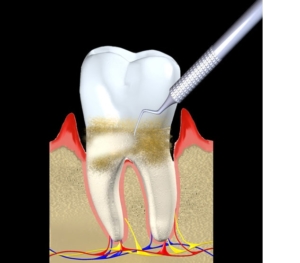
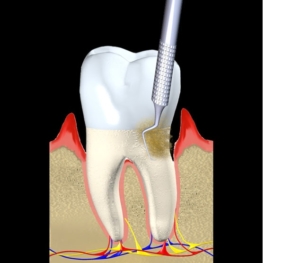
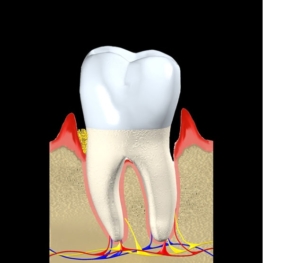
This would be the situation minutes after the procedure. Still inflamed, but no more plaque and calculus. If our patient brushes and cleans between their teeth each day, in a week or two they’ll be back to this healthy situation:

When periodontal disease is severe, Root Enhancements alone are not enough to restore health, since the damage to the bone and gums leaves the bad germs all kinds of places to hide and build anew. There are regenerative surgical techniques for this condition that we will explore on the next page. For now, the best advice is: see your dentist every six months. It’s better to kill the monster when it’s small, and intercepting early, localized gum disease is a lot easier than trying to fight it when it’s melted away a lot of bone.
Next up is a brief explanation of surgical techniques to treat periodontitis.
http://www.smilephiladelphian.com/surgical-periodontal-treatment/
